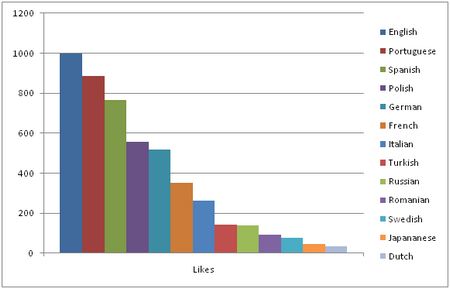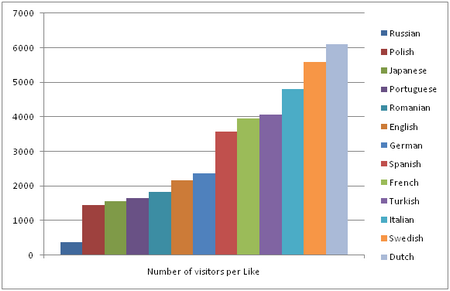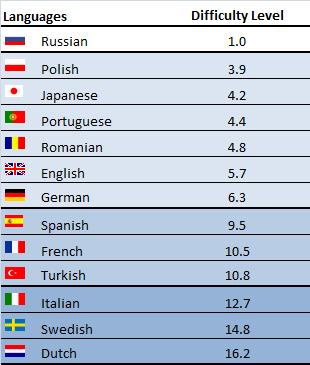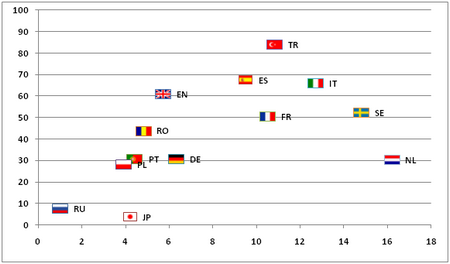We all know what an integral part of social media has become on the web. And the Like button is probably the most prominent example of how easy it is to “integrate” social media activities on your website. So after our last two introductory guides on online marketing (a Twitter guide and a Social Media Monitoring guide), we decided to crunch some numbers and share some statistics on the use of the Facebook Like button across languages with you. As our language portal is available (and used) in 19 different languages we are in the unique position to compare the exact same offering across languages.
Before we dig into the numbers, some points to consider:
- We gathered the Facebook Likes of our online dictionaries since adding the functionality in spring this year until August 31. Like Buttons are gathered by language (bab.la operates by language subdomains).
- The number of Internet users per country and Facebook users per country were taken from Internetworldstats. These are snapshots and quite recent numbers (March and June 2011 respectively) but they are not 100% accurate (we are comparing longitudinal Like button data with one-time user numbers). Nonetheless, we feel that the time frame considered is short enough to do this kind of comparison.
- Our visitor numbers are based on Google Analytics. As we gathered the Like buttons by language we grouped the bab.la users this way as well. In some countries (such as Switzerland) many languages are spoken so we needed to make a choice which language group the country belonged to. We checked on the country level which language subdomain was used most and then added the country accordingly.
Now, let’s take a look at the numbers. This first graph shows us raw data – how many Likes we have per language. As we can see, Spanish, Portuguese, and English each have over 700 Likes: they are the largest communities. At the far end, Japanese and Dutch have less than 50 Likes. However, these figures, albeit necessary, are limited in relevance, as they do not take into consideration the percentage of Facebook users in each language community.

The second graph is essential to find out the results this study is looking to find out. What we can read here is the percentage of Internet users registered to Facebook per language community. Among the most interesting results, it is to be noticed that the Turkish speaking Internet users have been widely seduced by Facebook – close to 85% of them are registered to it. Among Spanish, Italian and English speakers, nearly two thirds are on Facebook. Among the weaker markets, Russia and Japan are lagging behind as only ~8% and ~4% of the respective amount of Internet users have signed up to Facebook. The Japanese most successful social media is Mixi while Russian speakers widely use VK; hence the weaker Facebook share in these languages.

So which language has the most engaged users?
These are the first exclusive results we can analyze from our study. While we previously determined that the percentage of Russian Internet users registered at Facebook is very weak compared to other languages, that small amount is very active and inclined to like a page: every 377 visitors will like one of our dictionaries. The next most liking language community is already quite far behind with one like every 1,452 visitors and it is Polish. Third comes Japanese, which like Russian is a small yet dynamic Facebook community. Among the most reluctant language communities to like pages are the Italians, the Swedes, and finally the Dutch. They respectively give one like every 4,795, 5,583, and 6,109 visitors, even though Facebook is widely used in these countries. This is especially true for Italy where over 65% of Internet users are Facebook members.

How do Likes compare across languages?
As we have a very specific service offering we “restructured” the data a bit. This way it’s easier to interpret the results for your business:
Taking Russian as reference for the level of difficulty to get Likes, we obtain the following results:

We have divided the language communities into three categories: spontaneous Likers (3-7 points), cool-headed Likers (8-11 points), and reluctant Likers (12 points and more).
As mentioned, the Russian speaking community is by far the most inclined to like a lot, in spite of the limited influence of Facebook. Similarly, Polish, Japanese and Portuguese click on the Like button quite willingly, although less than a third of the Internet users are Facebook registered members. At the bottom of the table, Swedish and Italian are major users of Facebook (over 50% of Internet users), however, they are quite reluctant to click on the Like button. Similarly, Spanish, French, and Turkish communities have numerous registered Facebook users, especially Turkish and Spanish, respectively ranking 1st and 2nd. Nonetheless, these are cool-headed Likers and it takes an extra effort to have them liking on Facebook, in spite of the craze the social medium has been. Dutch is the only exception to this trend – they do give very few clicks per page; however, Facebook is not as widely used in the Netherlands (barely 30%of Internet users).
How do Likes compare across languages?
The result of this analysis is that the more Facebook is used in a country, the harder it is to get the users to click on Facebook Like button. Smaller communities, on the other hand, do it significantly more spontaneously. We see three possible explanations:
1. The usage of the Like button is different across countries and languages.
2. Early adopters are more likely to click on Like, the late majority more hesitant.
3. As Russia, Japan and Brazil have strong national social networks, people with an interest in foreign countries and languages are more likely to use Facebook as their international social network. And those people are more likely to “like” a language portal.
We have plotted the number of Facebook users (as a percentage of total Internet users) against the difficulty level. If one takes out Russia, Japan, and Brazil, there is no apparent pattern. Further taking out Dutch and Turkish (as outliers) there seems to be a slight upwards trend in the difficulty level the more Facebook users there are. So explanation 2 seems to get some (albeit mixed) support. Explanation 1 seems to be most likely. We, therefore, conclude that the engagement with the Like button is different amongst languages and countries.

We hope you enjoyed our little analysis. We’d gladly hear your thoughts. Maybe you even did your own analysis? Share your feedback in the comments below!